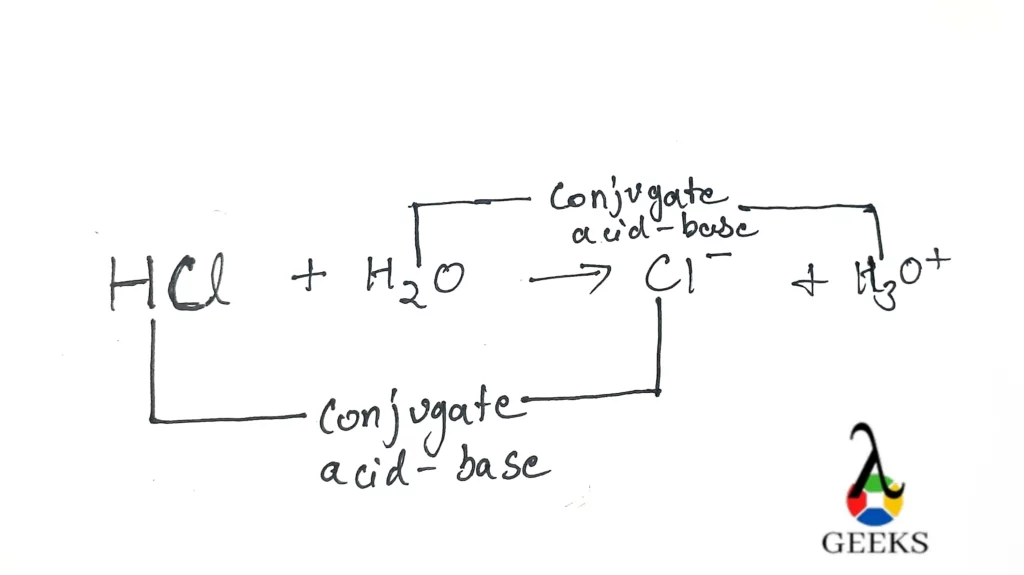HCl and H2O2 are chemical compounds present in an aqueous medium where HCl is a strong acid and hydrogen peroxide is a weak acid. Let us discuss HCl and H2O2 reactions.
HCl acid is also referred to as muriatic acid. In appearance, it seems to be colorless, and its molar mass is equal to 36.458 g/mol. The physical properties of HCl depend on its concentration. It is one of the most important acids because it is used as a reagent in chemical laboratories.
Hydrogen peroxide (H2O2 ) is a chemical compound which is acts as an acid and base also known as an amphoteric compound. In the following sections, we will study many facts based on HCl + H2O2 reaction. The conjugate pairs, intermolecular forces, etc.
What is the product of HCl and H2O2
The final product of the reaction of HCl and H2O2 is hypochlorous acid.
HCl(l) + H2O2(l) = HOCl(l) + H2O(l)
What type of reaction is HCl + H2O2
The reaction of HCl acid and H2O2 is a combination reaction because they form a specific product hypochlorous acid after being formed by the combination of two elements.
How to balance HCl + H2O2
Step 1: Writing the general equation
The general equation is HCl(l) + H2O2(l) = HOCl(l) + H2O(l)
Step 2: Arranging the similarity between the reactant and product
In the reaction, the number of moles of reactant must be equal to the number of moles of the product and the reaction have balanced moles.HOCl and H2O on both sides have one mole of Chlorine, 3 moles of Hydrogen, and 2 moles of Oxygen.
Step 3: Multiplying the coefficients with atoms in the reaction
The reaction is HCl(l) + H2O2(l) = HOCl(l) + H2O(l) and no need to multiply any of the atoms with any number.
Step 4: Writing the balanced equation
The balanced equation is HCl(l) + H2O2(l) = HOCl(l) + H2O(l)
HCl + H2O2 titration
The HCl + H2O2 titration is not possible because they both are acids Hydrochloric acid is very strong and Hydrogen peroxide is a weak acid but their endpoints cannot be calculated because of their acidic nature.
HCl + H2O2 net ionic equation
To write the net ionic reaction first write the complete equation with respective states.
HCl(l) + H2O(l) = HOCl(l) + H2O(l)
Now, split the compounds in the dissociative ions.
H+ + Cl– + H2+ + O– = H+ + OCl–+ H2O
Leftover H2O can be written as,
HOH = H+ + OH–
HCl + H2O2 conjugate pairs
HCl acid has the conjugate base Cl–but H2O2 is an amphoteric compound that is it behaves as both acid and base so, it does not contain any conjugate pair but forms a base H2O after donating an electron.

HCl and H2O2 intermolecular forces
- The intermolecular forces present in HCl are dipole-dipole interaction because of the ionic bond and London dispersion force.
- Hydrogen peroxide has 3 forces Van der Waal forces and hydrogen bonds with dipole-dipole interaction.
HCl + H2O2 reaction enthalpy
The reaction enthalpy of HCl and H2O2 is zero because they both are acids and the product is also an acid so, no amount of energy is needed or released In the reaction.
Is HCl + H2O2 a buffer solution
HCl acid and H2O2 are not buffered solutions because they both are acidic in nature though hydrogen peroxide is a weak acid still the pH of hydrochloric acid is strong which makes the solution more acidic.
Is HCl + H2O2 a complete reaction
HCl + H2O2 is a complete reaction. The reaction produces hypochlorous acid as a product, which is a complete chemical compound and can be further used for different chemical analyses.
Is HCl + H2O2 an exothermic or endothermic reaction
The reaction of HCl + H2O2 is an exothermic reaction, that is a good amount of heat is released while the reaction takes place.
Is HCl + H2O2 a redox reaction
The reaction HCl + H2O2 = HOCl + H2O is a redox reaction because of the presence of hydrogen peroxide, it will work as oxidizing and reducing agent and make the redox reaction.
Is HCl + H2O2 a precipitation reaction
HCl + H2O2 is not a precipitation reaction because of the amphoteric nature of hydrogen peroxide.
Is HCl + H2O2 reversible or irreversible reaction
HCl + H2O2 is a reversible reaction and can be reversed by adding chlorine in access so the hydrogen peroxide, gets collapsed into water and oxygen.
Is HCl + H2O2 displacement reaction
HCl + H2O2 is not a displacement reaction because this reaction forms a new acid without displacing any chemical compound.
How to balance HCl + H2O2 + Cu = CuCl2 + H2O
Step 1: Writing the general equation
The general equation is HCl + H2O2 + Cu = CuCl2 + H2O
Step 2: Arranging the similarity between the reactant and product
Calculate the number of moles to each atom in the reactant and produce one copper atom with hydrogen and one chlorine atom.
Step 3: Multiplying the coefficients with atoms in the reaction
Multiply coefficients to make them equal Multiply 2 with HCl, 2 with H2O2 and Cu will remain the same so, the final equation is –
2HCl + 2H2O2 + Cu = CuCl2 + 3H2O
Step 4: Writing the balanced equation
The balanced equation is 2HCl + 2H2O2 + Cu = CuCl2 + 3H2O
How to balance HCl + H2O2 + KI = I2 + KCl + H2O
Step 1: Writing the general equation
The general equation is , HCl + H2O2 + KI = I2 + KCl + H2O
Step 2: Arranging the similarity between the reactant and product
Calculate the number of moles to each atom in the reactant and produce one atom of potassium iodide with HCl and H2O2.
Step 3: Multiplying the coefficients with atoms in the reaction
Multiply coefficients to make them equal 2 with HCl, H2O2 + KI is the same so, the final equation is-
2HCl + H2O2 + KI = I2 + 2KCl + 2H2O
Step 4: Writing the balanced equation
The final balanced equation is 2HCl + H2O2 + KI = I2 + 2KCl + 2H2O
How to balance HCl + H2O2 + KMnO4 = O2 + MnCl2 + KCl + H2O
Step 1: Writing the general equation
Write the general equation, HCl + H2O2 + KMnO4 = O2 + MnCl2 + KCl + H2O
Step 2: Arranging the similarity between the reactant and product
Calculate the number of moles to each atom in the reactant and product too so that the equation can be written in a balanced form.
Step 3: Multiplying the coefficients with atoms in the reaction
Multiply coefficients to make them equal 6 with HCl 2 with 2KMnO4 so, the final equation is-
6HCl + H2O2 + 2KMnO4 = O2 + 2MnCl2 + 2KCl + 4H2O
Step 4: Writing the balanced equation
The final equation is, 6HCl + H2O2 + 2KMnO4 = O2 + 2MnCl2 + 2KCl + 4H2O
How to balance HCl + H2O2 + Au = AuCl + H2 O
Step 1: Writing the general equation
Write the general equation, HCl + H2O2 + Au = AuCl + H2O
Step 2: Arranging the similarity between the reactant and product
Calculate the number of moles to each atom in the reactant and product too so that it can be further multiplied.
Step 3: Multiplying the coefficients with atoms in the reaction
Multiply coefficients to make them equal 2 with HCl and 2 with Au so, the final equation is-
2HCl + H2O2 +2Au = 2AuCl + 2H2O
Step 4: Writing the balanced equation
The final equation is, 2HCl + H2O2 +2Au = 2AuCl + 2H2O
How to balance HCl + H2O2 + FeCl2 = FeCl3 + H2O
Step 1: Writing the general equation
Write the general equation,
HCl + H2O2 + FeCl2 = FeCl3 + H2O
Step 2: Arranging the similarity between the reactant and product
Calculate the number of moles to each atom in the reactant and product too so that the atoms can be multiplied.
Step 3: Multiplying the coefficients with atoms in the reaction
Multiply coefficients to make them equal 2 with HCl and 2 with FeCl2 so, the final equation is-
2HCl + H2O2 + 2FeCl2 = 2FeCl3 + 2H2O
Step 4: Writing the balanced equation
The final equation is 2HCl + H2O2 + 2FeCl2 = 2FeCl3 + 2H2O
How to balance HCl + H2O2 + K2Cr2O7 = CrCl3 + O2 + H2O + KCl
Step 1: Writing the general equation
Write the general equation,
HCl + H2O2 + K2Cr2O7 = CrCl3 + O2 + H2O + KCl
Step 2: Arranging the similarity between the reactant and product
Calculate the moles to each atom in the reactant and product too so that the equation can be multiplied further.
Step 3: Multiplying the coefficients with atoms in the reaction
Multiply coefficients to make them equal 8 with HCl, 2 with KCl, and 2 with CrCl3 so, the final equation is-
8HCl + H2O2 + K2Cr2O7 = 2CrCl3 + 2O2 +5H2O +2KCl
Step 4: Writing the balanced equation
The final balanced equation is 8HCl + H2O2 + K2Cr2O7 = 2CrCl3 + 2O2 +5H2O +2KCl
Conclusion
Hydrochloric acid is a chemical compound that is highly reactive and behaves as strong acid while Hydrogen peroxide is amphoteric in nature and can be used as a bleaching agent and as an antiseptic too.

Hi….I am Soumya Chourasia, completed my Master’s in Chemistry. I am working as a Subject Matter Expert in Chemistry. Before this, I used to teach chemistry for competitive examinations and school as well.
Let’s connect through LinkedIn here,